The Chemistry labs
The William F. 沃尔什科学中心包括普通和有机化学实验室. Walsh G09 is a general chemistry lab and as such, 作为新生进入化学101基础化学理论的切入点, CHML 101, CHEM 102, & CHML 102. The organic chemistry lab, Walsh G10, 提供空间,使CHML 301和CHML 302的每个学生都可以在通风柜中工作,并在完全安全的情况下进行有机反应.
The Research Lab
化学系研究实验室是专为学生执行新的和令人兴奋的研究化学与教师顾问从我们部门. 研究实验室位于De La Roche 314,在化学套房的大厅下面. It has been recently renovated with new hood space, study areas/desks, 空气敏感设备以及标准化学研究设备.
研究实验室位于我们的核磁共振光谱仪(NMR)旁边。, FT-IR, Liquid Chromatography Mass Spectrometer (LC-MS), Gas Chromatography Mass Spectrometer (GC-MS), UV-Vis, and Inductively Coupled Plasma Mass Spectrometer (ICP-MS), making for a seamless research experience. (For information about these instruments, see below.)
The Department of Chemistry has a wide array of instruments. They are housed in De La Roche 315, 在化学研究实验室的隔壁,从化学套房穿过大厅.
Nuclear Magnetic Resonance Spectrometer
 这些新仪器中最大的是核磁共振光谱仪. 大家称之为“NMR”的仪器是JEOL ECS 400.
这些新仪器中最大的是核磁共振光谱仪. 大家称之为“NMR”的仪器是JEOL ECS 400.
An NMR is commonly used in determining chemical structures, understanding chemical and enzyme kinetics, determining protein structures, and in a variety of other chemical, physical, and biological applications. 它是工业、学术界和政府进行化学表征的标准工具.
核磁共振的工作原理与核磁共振成像(MRI)相同,通过激发原子来了解它们独特的环境. The spectrometer is a complex system which, at its core, 利用一个超导磁体,通过液氦和液氮冷却,保持在-459华氏度. 我们的400 MHz高场核磁共振是领先的研究标准(目前), 是否有自动化能力连续对24个不同的样品进行无数次实验, 并使用了一款名为Delta的革命性软件,即使是初学者也可以使用.
For a Chemistry major at St. Bonaventure,在有机化学I (CHEM 301)的二年级就开始了核磁共振的培训 & CHML 301). 在上面的照片中,有机化学专业的学生正在学习核磁共振的使用. 训练后,学生自己使用仪器,有时没有直接监督. 核磁共振的广泛使用继续在物理化学II (CHEM 402) & CHML 402) as well as Instrumental Analysis (CHEM 431 & CHML 431). 它也经常用于化学系教师正在进行的研究.
Multimode Quad-Core Xeon-Based Server Computer
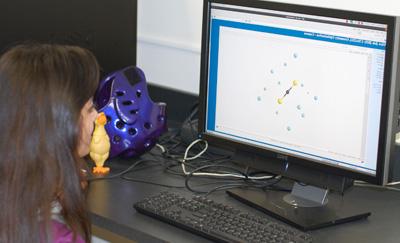 这个计算机集群配备了Spartan计算建模软件来执行各种类型的计算化学,如分子力学, semi-empirical, ab initio, and density functional theory calculations.
这个计算机集群配备了Spartan计算建模软件来执行各种类型的计算化学,如分子力学, semi-empirical, ab initio, and density functional theory calculations.
计算化学是理论化学的一个不断发展的领域,具有多种应用,例如将潜在药物“对接”到酶活性位点.
在照片中,一名学生正在进行计算,这是她指导的研究的一部分.
Glove Box
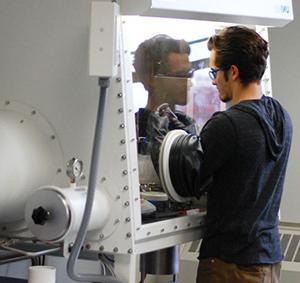 我们的MBraun Unilab手套箱于2012年安装,允许我们的教师和学生研究人员在无氧的大气中研究高度不稳定的材料和复合物.
我们的MBraun Unilab手套箱于2012年安装,允许我们的教师和学生研究人员在无氧的大气中研究高度不稳定的材料和复合物.
手套箱已被用于金属配合物的研究.
在右边的照片中,一个学生在手套箱里为即将到来的反应做准备.
Fluorimeter
Olis ArcOptix荧光计测量给定物质和化合物在七个不同波长下的荧光发射.
When a molecule is excited with light, 有时分子会发出不同波长的光. 这是荧光,荧光仪可以量化这种发光. Applications are found in medicine, biochemistry, and forensics.
Raman Spectrophotometer
The DeltaNu Raman spectrometer is used to observe vibrational, rotational, 和其他低频激发模式,是我们红外光谱仪的补充. 拉曼光谱通常用于分析晶体的形态和堆积. 它还用于手术过程中的麻醉药监测和纳米技术领域,用于分析纳米结构,如纳米晶体, nanotubes, and graphene.
FT- Infrared Spectrophotometer
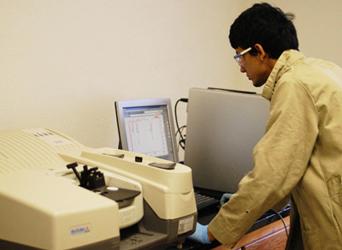 我们的Nicolet Nexus 670 FT-IR使我们能够激发特定的化学键来确定结构或通过其特征红外“指纹”识别化合物。. 我们的仪器还允许ATR采样,这导致非常简单的样品制备.
我们的Nicolet Nexus 670 FT-IR使我们能够激发特定的化学键来确定结构或通过其特征红外“指纹”识别化合物。. 我们的仪器还允许ATR采样,这导致非常简单的样品制备.
学生可以期望在二年级时使用这种乐器. It is often used in manufacturing for quality control, in plastics analysis, and in forensics, such as to measure blood alcohol content.
In the photo to the right, a student runs an IR sample.
Liquid Chromatography Mass Spectrometer
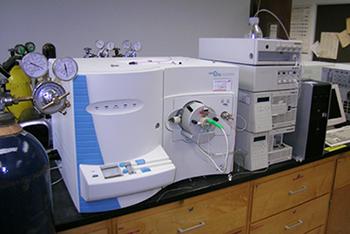 液相色谱质谱仪是一种功能强大的仪器,它结合了高效液相色谱(HPLC)的物理分离能力和质谱的质量分析能力.
液相色谱质谱仪是一种功能强大的仪器,它结合了高效液相色谱(HPLC)的物理分离能力和质谱的质量分析能力.
LC-MS是制药和化工行业的标准设备. It's important in quality control, drug development, 同时测试药物的药代动力学,看看它从体内清除的速度有多快. It has also been used extensively in proteomics, 人类基因组测序的后续研究领域.
Gas Chromatography Mass Spectrometer
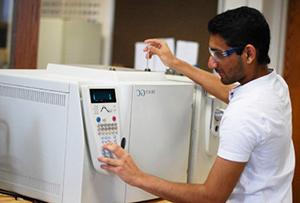 The Liquid Chromatography Mass Spectrometer, described above, 补充了我们之前获得的气相色谱质谱仪.
The Liquid Chromatography Mass Spectrometer, described above, 补充了我们之前获得的气相色谱质谱仪.
气相色谱-质谱法在环境化学物质鉴别中具有重要的作用, forensics, astro-chemistry, food analysis, and medicine.
In the photo, a student tests a sample on the GC-MS.
Ultraviolet-Visible Spectrophotometer
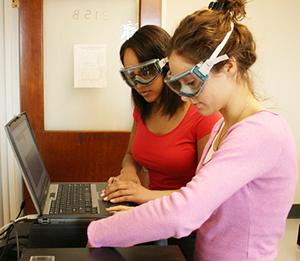 紫外可见分光光度计测量分子在紫外或可见光区域吸收特定波长光子的能力.
紫外可见分光光度计测量分子在紫外或可见光区域吸收特定波长光子的能力.
The UV-Vis is often used to measure oxidation states of metals, conjugation in organic molecules, and charge transfer between two or more different molecules.
In the photo, Chemistry students place a sample in the UV-Vis.